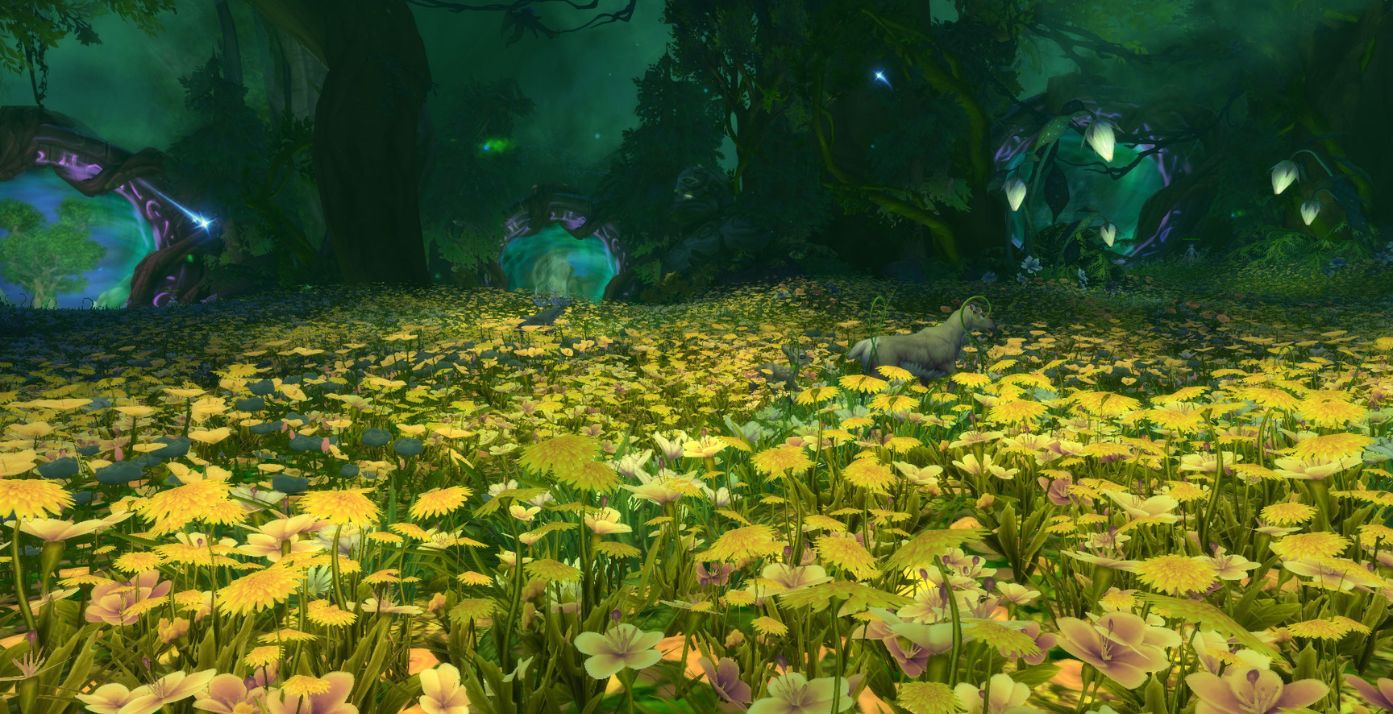With Warcraft’s 30th anniversary, Blizzard has finally announced an addition to World of Warcraft that players have been waiting for: WoW player housing. As part of the Midnight expansion, where players’ next adventure begins at home, this addition brings the potential to create a truly personal space in Azeroth. But for this feature to succeed, it has to go beyond a basic home base.
WoW player housing must be immersive, deeply customizable, and community-focused to honor the game’s roots. Here’s what WoW player housing needs to include to land with players and feel like a true home in Azeroth.
1. Deep Customization and Personalization That Tells Your Story

While building a cozy space should be a given, WoW player housing should be about telling the story of each player’s journey through Azeroth. Blizzard’s WoW player housing trailer showed glimpses of iconic artifacts, like Onyxia’s head, famous loot, and other legendary weapons. WoW player housing should be a place where players can bring together these milestones, displaying trophies that reflect their accomplishments and epic battles. Imagine a room where players can line their walls with rare weapons, mounts, and relics of major events, building a personalized museum of their character’s achievements.
Customization in WoW player housing should allow players to set up these displays in ways that feel meaningful, celebrating each stage of their journey—from early dungeon clears to world-first raids. WoW player housing should also honor the individuality of guilds and communities, with unique options for those who’ve shared these experiences together. Rather than just looking nice, each player’s home should feel like a chronicle of their growth as a hero, capturing the depth and history of their adventures in Azeroth. This is where WoW player housing could truly shine, by letting players craft spaces that reflect the unique paths they’ve carved in this vast world we have protected for so long.
2. Freedom to Choose Location, Style, and Environment Without Faction Limits

For WoW player housing to feel like a true reflection of the player’s journey, it needs to go beyond race and faction limitations. Imagine a blood elf death knight wanting to live in a somber, undead-themed area, rather than being restricted to a traditional blood elf aesthetic. Or a human who feels more connected to the rich histories of both factions, wanting a WoW player housing setup that showcases time spent as a Horde druid in Wrath of the Lich King alongside newer Alliance achievements.
WoW player housing should embrace the complexity of these journeys, allowing players to set up homes in environments that best represent their experiences, whether that’s a snowy Northrend backdrop, an undead encampment, or a Pandarian forest.
To honor WoW’s evolution from faction conflict to unified collaboration, WoW player housing should be free of faction-based restrictions. Players should be able to display memories from all stages of their journeys—whether they’ve been Horde, Alliance, or both. The house’s location could determine the surrounding environment, while the interior is completely customizable, reflecting each character’s unique story. This way players feel empowered to create homes that represent where they’ve come from, who they are now, and the shared history they’ve forged with others across Azeroth.
3. Guild and Community Housing Options That Reflect WoW’s Social Core

WoW has always been about community, so WoW player housing needs to offer more than individualized spaces. Guild or community housing could bring this social aspect front and center, allowing guilds to create shared spaces where they can display collective achievements, host gatherings, and deepen bonds. These should be instanced areas where players walk into a “guild village” or shared community hub, where different homes and guild spaces are located together.
As WoW has evolved beyond strict Horde vs. Alliance divides, cross-faction community areas should be an option. Imagine a place where players from different factions can coexist and showcase their collective pride, reinforcing the shared world of Azeroth rather than isolating players.
Integrating player-run economies and role-playing opportunities could further deepen the community aspect of WoW player housing. For example, players could establish small vendors or trade stations within their housing areas, where they can sell crafted goods or unique items. This would provide an alternative to the main Auction House and foster a local economy within housing communities.
Players could role-play as innkeepers, merchants, or even tavern owners, opening their homes for friends or guildmates to gather, trade, and socialize. These opportunities would encourage both casual interactions and immersive role-playing, creating a rich, player-driven ecosystem within the game’s housing system.
To ensure that WoW player housing remains a positive, inclusive space, accessibility features and strong moderation options would be essential. Players should have robust controls over permissions, so they can decide who enters their space, how items are displayed, and even limit trade interactions if desired. Moderation tools could also help prevent any negative behaviors, while accessibility options—such as adjustable layouts and alternative modes of interaction—would make WoW player housing enjoyable for all.
By allowing players to customize their communities while keeping inclusivity and moderation at the forefront, WoW player housing could evolve into a vibrant, welcoming space that reflects the best aspects of Azeroth’s shared world.
4. A House Attendant for Accessibility and Progression

WoW player housing should include a “house attendant” NPC—think of Scanlan’s floating helpers in Critical Role’s Chateau Shorthalt—that serves as both a functional guide and a customizable companion. This attendant could help players get started with a base layout, manage decorations, and even give updates on housing achievements. For players who may not want to dive deeply into decorating, this attendant could handle essentials, providing an easy setup so players can enjoy a furnished home without the hassle of arranging every detail.
The attendant could take various forms based on player preference—a ghostly spirit, a friendly robot crafted by goblins, or even a Mr. Handy-style helper that’s always ready to lend a hand. This would add accessibility, allowing players who prefer a streamlined experience to enjoy the benefits of WoW player housing while still giving customization enthusiasts the freedom to personalize every aspect. By making the attendant a charming, interactive presence, WoW could create a more welcoming and accessible experience for all players.
5. Room Variability and Trophy Display Options

For World of Warcraft player housing to truly feel unique and immersive, there needs to be a variety of customizable room types beyond just a standard trophy room. Players should have the freedom to create spaces that reflect their character’s journey and personal style. Whether it’s a cozy lounge area, a grand armory showcasing weapons from past raids, a library filled with lore-rich artifacts, or even a kitchen for role-playing moments, room variability can transform housing into a personalized haven.
In a nod to WoW’s own in-game carnivals like Darkmoon Faire and Blizzard’s broader universe, WoW player housing could offer a “game room” where players can gather with friends to play mini-games. Imagine unlocking arcade-style mini-games as housing achievements—perhaps a mini Hearthstone table, a simplified game of Darkmoon Faire ring toss, or even a chess-like strategy game inspired by Warcraft III. This would add an interactive, fun social element to housing, allowing players to entertain guests and celebrate WoW’s rich heritage of in-game events and lore-inspired activities.
This room could be used to host in-game tournaments, complete challenges with friends, or simply relax after a tough raid. Adding a mini-game room would reinforce the social dimension of WoW player housing, allowing it to be more than just a space for personal displays and achievements. It would become a gathering spot where players can unwind, interact, and create new memories. From Darkmoon games to Hearthstone-inspired challenges, these mini-games would make WoW player housing a true home that captures the best of Azeroth’s traditions and its players’ creativity.
In addition to versatile room layouts, a dedicated trophy room is essential for displaying accomplishments. This should allow players to highlight major achievements, from Onyxia’s head to the legendary Illidian’s war glaives, with placement options that can be arranged for aesthetic appeal or theme. Adding options for interactive elements—like training dummies, relic pedestals, or bookcases that hold collectible lore items—can also deepen the personalization.
6. Social and Storytelling Features to Foster Shared Experiences

One of the most powerful aspects of World of Warcraft is its ability to bring people together, not just in gameplay but in shared stories and lasting memories. The WoW Netflix documentary, The Remarkable Life of Ibelin, captures stories like that of the child with Duchenne muscular dystrophy who found a second life and community within Azeroth. WoW player housing should support and celebrate these connections by giving players a space to gather, reminisce, and share their journeys with others. To do this, housing can’t just be a solo space—it has to offer communal features that allow friends, guildmates, and even the larger WoW community to experience these stories together.
To make this possible, WoW player housing should offer robust permissions settings. Players could choose to open their homes to others or create special “event” modes where they can invite friends over for gatherings, storytelling sessions, or roleplay.
WoW player housing would become a place where achievements and items tell the stories of the player’s journey in Azeroth, with others able to walk through these spaces, interact with elements, and add to the experience. By enabling players to share their spaces and control how those spaces are experienced, WoW player housing would deepen its role as a social hub, celebrating the bonds, memories, and unique stories that make WoW so meaningful.
7. Building System with Flexible Views to Honor WoW’s Legacy

World of Warcraft started as a top-down, real-time strategy game. Over the years, Blizzard has shown it can innovate in ways that respect WoW’s origins while delivering modern, intuitive experiences. The housing system should be no exception. A robust building interface that includes top-down and close-up views would cater to the game’s established players and feel familiar to fans of other games with player housing. With Blizzard’s expertise in offering flexible play styles—like introducing dragon riding with adjustable settings—it’s clear they have the potential to make housing flexible and engaging for everyone.
Providing multiple views during building, such as a top-down perspective inspired by WoW’s RTS roots alongside a first- or third-person view, would offer players a sense of freedom and precision. This flexibility would let players focus on intricate details when they want to go all-in on decorating while also giving them the broader overview needed for layout planning.
It’s not just about adding a different camera angle—it’s about making the system as fluid as WoW’s other gameplay mechanics, where players can control their experience and craft their space in ways that reflect their creativity and personal style.
8. More Than Garrison 2.0 and Encourages Exploration

While WoW player housing should offer meaningful customization and amenities, it’s essential to limit certain functionalities to maintain the immersive scale of Azeroth. WoW player housing should feel personal but grounded in WoW’s vast world, where the story continues to unfold in central hubs and iconic locations, preserving the game’s epic scale.
Players shouldn’t expect to meet major lore characters like Thrall or the Council of the Horde in a private residence. Instead, significant interactions and story events should remain anchored in the main cities, reinforcing the idea that each player is part of a much larger world.
This approach doesn’t mean housing can’t serve as a bustling space for player interaction. Still, it does mean that WoW should strike a balance between making housing a customizable retreat and keeping certain core elements tied to Azeroth’s shared hubs. Players should have enough functionality within their homes to feel like they’re managing a base of operations—but major plot points, legendary NPCs, and large-scale events should remain in cities, dungeons, and battlegrounds. Players should gather in these hubs for important lore interactions, epic battles, and shared experiences that shape the world.
Encouraging exploration beyond housing also deepens the roleplay experience. Imagine players running personal businesses or gathering spots in their homes while still needing to travel to the city to handle matters of state, trade, or council meetings. This structure would respect the scale of WoW’s world and keep the player’s individual home from feeling like a one-stop-shop, reminding them that they are part of an epic, interconnected world. Maintaining this separation between private and public spaces upholds WoW’s sense of immersion, ensuring that player housing remains a special retreat while keeping the broader game world central to the player’s adventure.
9. Seasonal Decorations Linked to Azeroth’s World Events

One of the most charming parts of WoW is its calendar of seasonal events, with Azeroth celebrating everything from Winter Veil to Hallow’s End and the Lunar Festival. WoW player housing could extend these beloved events by allowing players to decorate their homes in sync with the world. Imagine being able to hang Winter Veil lights, set up Day of the Dead altars, or carve pumpkins for Hallow’s End.
Blizzard could even offer seasonal quests or achievements tied to these decorations, letting players earn limited-time decor items that make their homes feel alive with the spirit of each holiday. Seasonal decorations would make housing feel dynamic and tied to the game’s universe, creating a sense of excitement and giving players another reason to check in as new events roll around.
Additionally, these seasonal elements could be collectible over time, rewarding players for participating in WoW’s full range of world events and expanding their home decor options each year. The seasonal decor would allow homes to feel vibrant and connected to Azeroth’s rhythms, inviting players to celebrate the game’s history and cultures within their own spaces. Whether it’s a Lunar Festival lantern hanging outside or Hallow’s End scarecrows in the yard, seasonal decorations would add to WoW player housing’s sense of immersion and make each home truly feel like a part of Azeroth.
10. Class-Specific Features to Celebrate Identity

With World of Warcraft becoming increasingly alt-friendly, it’s easy to lose sight of what makes your main feel special. Class-specific features in player housing could help reignite that connection by giving each class a unique touchstone that reinforces its identity. Imagine druids having a backyard access point to the Emerald Dreamway, mages creating custom portals in their housing, or warlocks summoning demons in a shadowy sanctum. Hunters could even build interactive stables showcasing their pets, while death knights forge runeblades at a class-specific forge.
These features wouldn’t just add depth to housing—they’d bring back a sense of class pride, which has faded as buffs and abilities have become less impactful. For players juggling multiple alts, this system could re-establish a sense of uniqueness, while shared housing with guildmates or friends could highlight these differences. Class-specific elements in WoW player housing could celebrate individuality while fostering collaboration, making the system feel dynamic, meaningful, and rooted in what makes World of Warcraft’s classes so iconic.
WoW player housing has the potential tobe much more than a simple place to log out. By focusing on community, customization, and a deep connection to Azeroth’s world, Blizzard can make housing a place where players feel at home in WoW.
The key is striking a balance: offering enough customization to make spaces personal while preserving the community aspect that has always been at the heart of WoW. With these features, WoW player housing could become a treasured feature, a place where players’ personal stories and connections come to life, honoring Warcraft’s legacy while looking toward the future.








